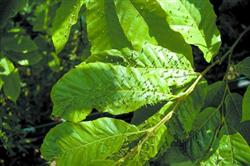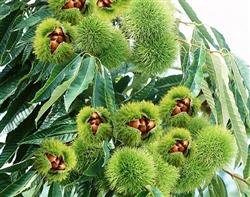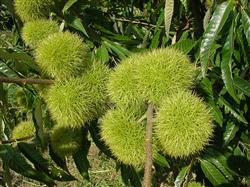What are the main pests of Chinese chestnut?

What are the main pests of Chinese chestnut? Please introduce the occurrence characteristics and control methods of chestnut gall wasp and cloud spot longicorn beetle as follows: first, chestnut gall wasp 1. The morphological characteristics of adults are black wasps, with a body length of 2mi 3mm and transparent front and rear wings. The egg is oval, 0.1Mel 0.2 mm long, milky white, with a filamentous short stalk at the tail end. The larva is 2mi 3mm long, spindle-shaped, stout, legless. The body is slightly pointed at both ends, milky white and brown mouthparts. The pupa is naked, with a body length of 2.5ml / 3mm, colostrum white, black during Eclosion, and red compound eyes. 2. Habits and harmful characteristics of chestnut gall wasps occur one generation a year, and the first instar larvae overwinter in the damaged chestnut buds. The larvae in the budding stage of Castanea mollissima began to move from mid-March and late March to early April in the following year, and the damaged buds gradually expanded to form galls. The gall tumor is round or irregular oval, hard, cherry red, sometimes with deformed leaflets on the gall tumor, which has a serious impact on the civilization, leaves and tips of chestnut trees. The insect began to pupate in early May and emerged as adults in large numbers in mid-June. After Eclosion, the adults stay in the gall for 10 miles for 15 days and then bite a hole and drill out, laying eggs in full buds, usually laying 3 eggs per bud. Adult tumor activity is mostly in the daytime, mostly from 8 am to 12:00, sunny and windless weather is conducive to adult tumor activity, its flying ability is not strong, most of the time crawling in trees. The larvae hatch from the end of July to the first and middle of September, feed on the buds and form chambers, and overwintering begins in late September. 3. The control method: remove the gall branches before the end of May. From April to May before the adult Eclosion, all the nodular branches and leaves in the same year will be cut off and burned out of the garden, so as to prevent the emergence and reproduction of the chestnut gall wasp in the tumor. This measure is done thoroughly and carried out in the chestnut area, the harm can be eliminated. Implement intensity pruning to the seriously damaged trees and strengthen fertilizer and water management in order to enhance the tree potential. Spray the canopy during the adult occurrence period from June to July. If the previous measure is not done thoroughly, spray remedy. During the peak period of the nodulation activity of chestnut gall wasp (usually from mid-June to early July), spray 50% fenitrothion 800 color 1000 times or 80% dichlorvos 800 color 1000 times or 90% trichlorfon crystal 800 1000 times, spray the canopy twice in the morning on a sunny day, spray it for the first time in mid-June, and spray again in 10 days after leaves. Chestnut gall wasp has parasitic natural enemies, so try not to spray leaves on trees. 2. Monochamus alternatus 1. The morphological characteristics of the adult worm are 32ml 97mm long, black or dark brown, with two kidney-shaped leukoplakia on the forechest dorsal plate and three rows of cloudy leukoplakia of different sizes on the sheath wing. The egg is long oval, yellowish, about 8mi 9mm long. The larva is 70ml 80mm long, milky white or yellowish, with a "mountain" shaped brown spot on the forechest dorsal plate. The pupa is 40ml 70mm long, milky white to yellowish. 2. Habits and harmful characteristics of Monochamus alternatus occurs every two years, overwintering as adults or larvae in the trunk. The adults appeared from April to June, fed on leaves and twigs, and began to mate and lay eggs about 40 days after feeding. The flying ability of adults is weak, and it is easy to fall to the ground and crawl when they are shaken. During the occurrence of adults, we can make use of this habit to shake trees and kill them. Adults usually lay eggs on the trunk within 2 meters from the ground. When laying eggs, they first bite into soybean-sized grooves in the bark, and then lay eggs in the trough. After hatching, the larvae were eaten into triangular cavities under the bark, and a large amount of dung debris was discharged from the hole, and the bark gradually expanded and split longitudinally. After the larvae endanger in the bark for a period of time, they enter the xylem and feed upward along the trunk when they reach the pith, and when serious, the whole tree dies. In the second year, it pupated in the insect path in August, feathered into an adult in September, and bit a round hole to get out of the tree trunk from April to June in the third year. 3 Control methods (1) the main work of artificial control is artificial scraping of eggs and newly hatched larvae. The oviposition site of Monochamus alternatus is low, and the spawning marks and the harm of newly hatched larvae are obvious. The oviposition of adults and the hatching period of larvae should be checked frequently from May to July. It is found that there are signs of spawning and harmful parts of newly hatched larvae on the tree trunk. Scrape them off with a sharp knife in time and apply 40% omethoate 10 times liquid to destroy the larvae in the early stage of subcutaneous harm. This method has fast work efficiency and good effect, and it is a very important measure for prevention and control. (2) after the application of wormhole for 4 months, the tree trunk should be checked frequently, and it was found that there were fresh insect droppings of longicorn beetle larvae on the trunk. The dung shavings in the wormhole should be removed in time and killed with steel wire hook, or cotton balls should be dipped in dichlorvos solution and gasoline should be stuffed into the wormhole for fumigation, and the wormhole should be sealed with wet mud after application. (3) in late April, 10 kg of quicklime, 1 kg of sulfur, 50 g of salt and 20 kg of water were used to brush the trunk less than 2 meters before adult spawning to prevent adult spawning. Click to get more chestnut planting techniques click to get more fruit planting techniques
- Prev

How to make Chinese chestnut fruitful?
How to make Chinese chestnut fruitful? Please introduce the method so that the high yield of the planted chestnut can be referred to the following methods: first, close planting can not only increase the early yield and obtain economic benefits as soon as possible, but also facilitate intensive management of the orchard. Planting density: the row spacing is generally 2 m × 4.
- Next

How to fertilize chestnut scientifically?
How to fertilize chestnut scientifically? Please give a detailed description of chestnut fertilizer requirements like other fruit trees, the difference is that in addition to sufficient nitrogen, phosphorus and potassium, it is particularly sensitive to medium element magnesium and a small amount of manganese and boron, such as lack or deficiency, serious physiological obstacles will occur and affect growth and development. According to the measurement.
Related
- Moge, come on! The staff of the peasant association in the producing area of cantaloupe were frightened when the crowd gathered.
- Causes and Solutions of low Fruit setting rate of Apple
- Symptoms and control measures of passion fruit virus disease
- Fruit growing lesson: how do apple orchards keep high yields?
- Can you build orchards in the mountains? What are the pros and cons?
- How to manage the coloring period of Crisson grape?
- This paper introduces the processing technology of two kinds of fig products.
- How much is a month for retired teachers in rural areas by 2020?
- How can strawberry planting increase sugar content? We should pay attention to management in many aspects.
- What are the cultivation techniques on how to improve the yield of golden fruit?

